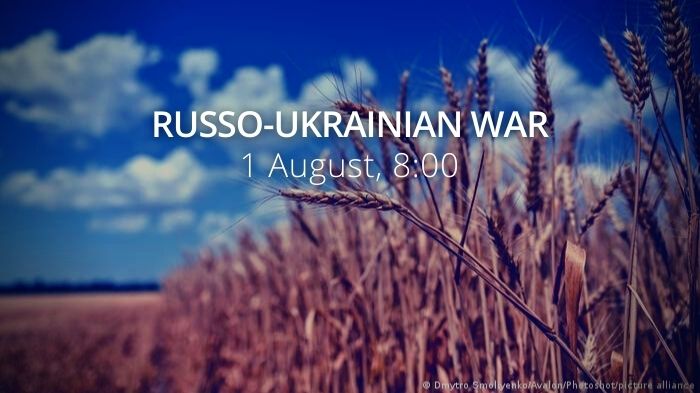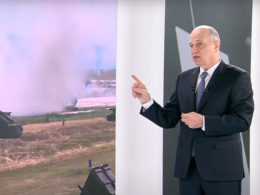An explosion at a military factory near Moscow. Moscow under a night drone attack. Russian attack on Zaporizhzhia residential area claims three lives.
We are continuing our series of Patron Talks, exclusive to Euromaidan Press patrons. This time, our speaker is Mykola Bielieskov, Research Fellow at National Institute for Strategic Studies under UA President/senior analyst at Come back Alive. Join us, sign up on Patreon to support us, and ask our experts questions!

Daily overview — Summary report, August 10

According to information from the General Staff as of 06.00 10.08.2023, supplemented by its [18:00 assessment].
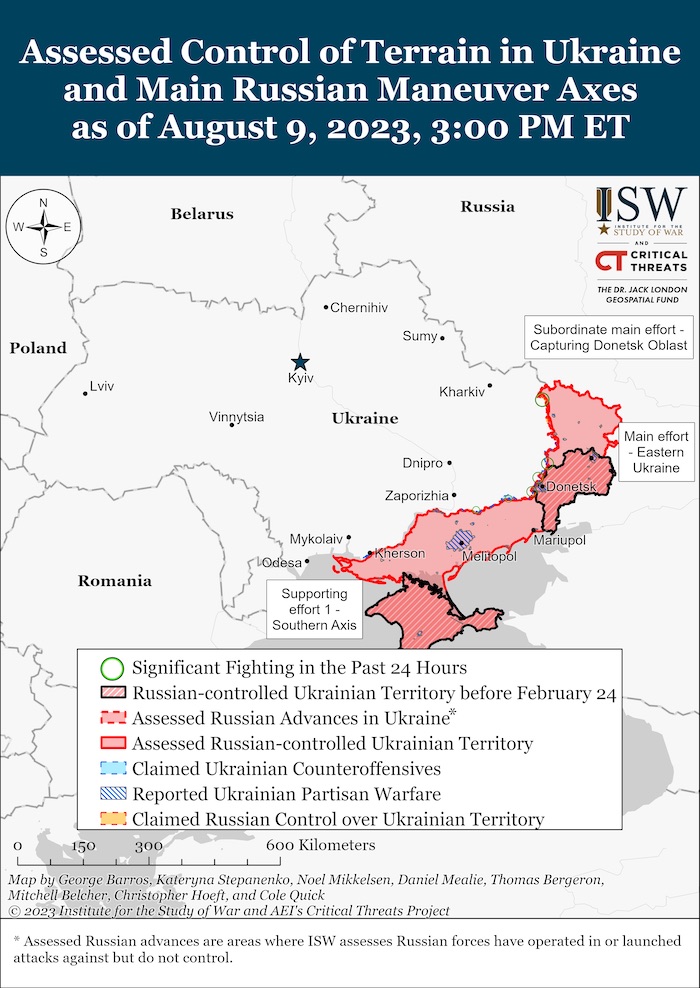
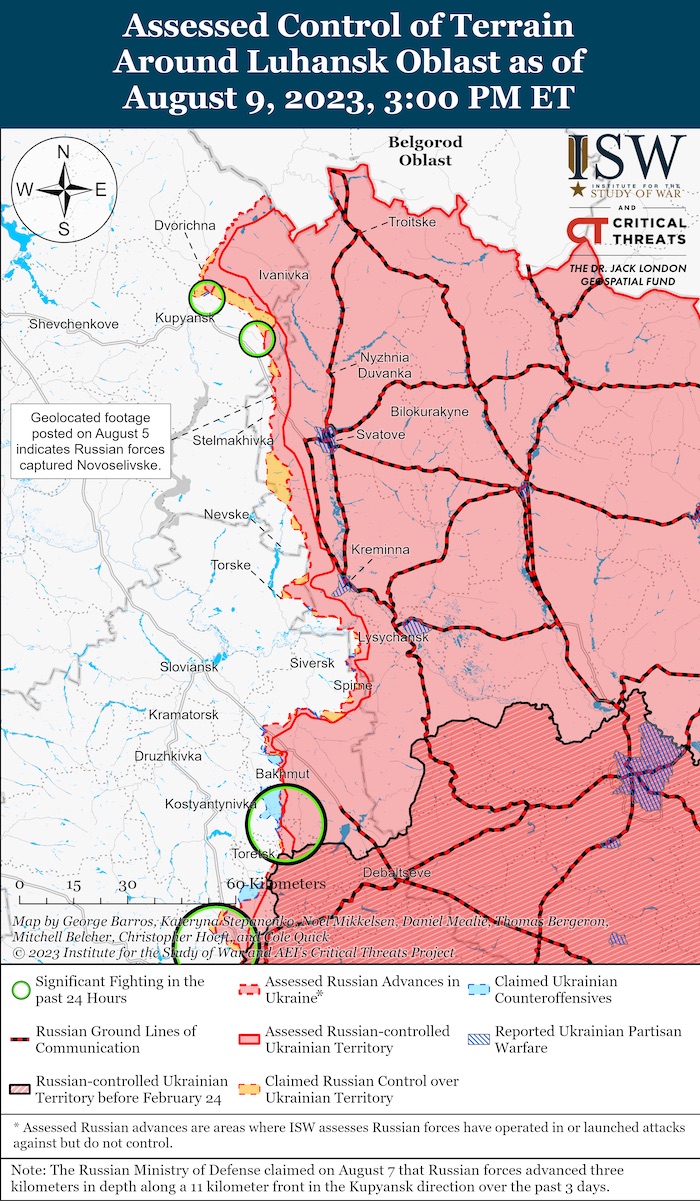
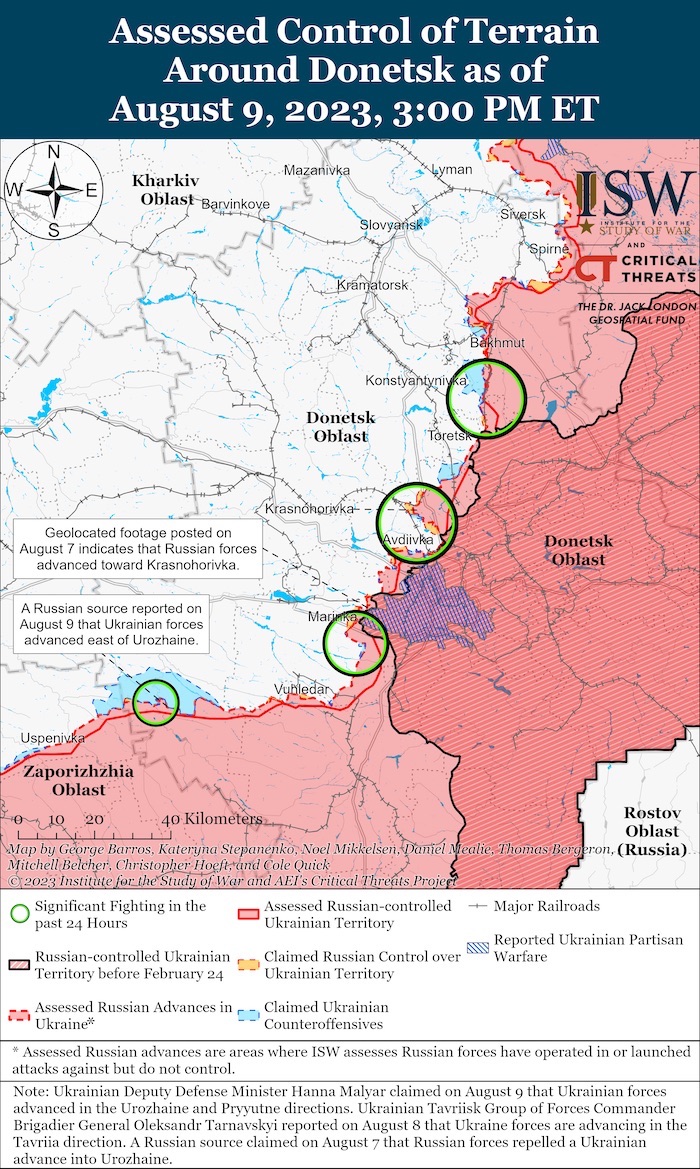
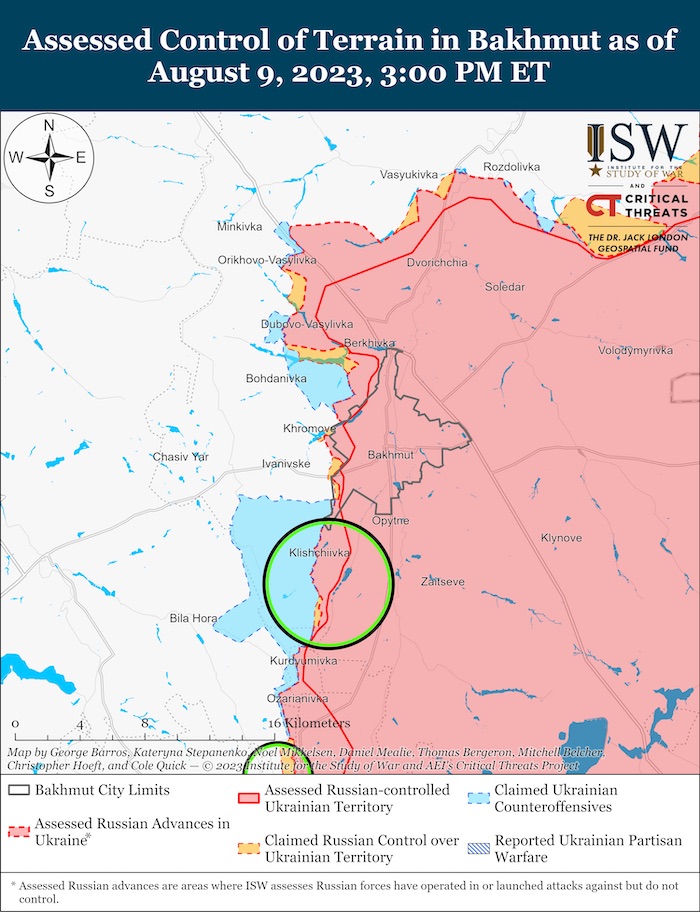
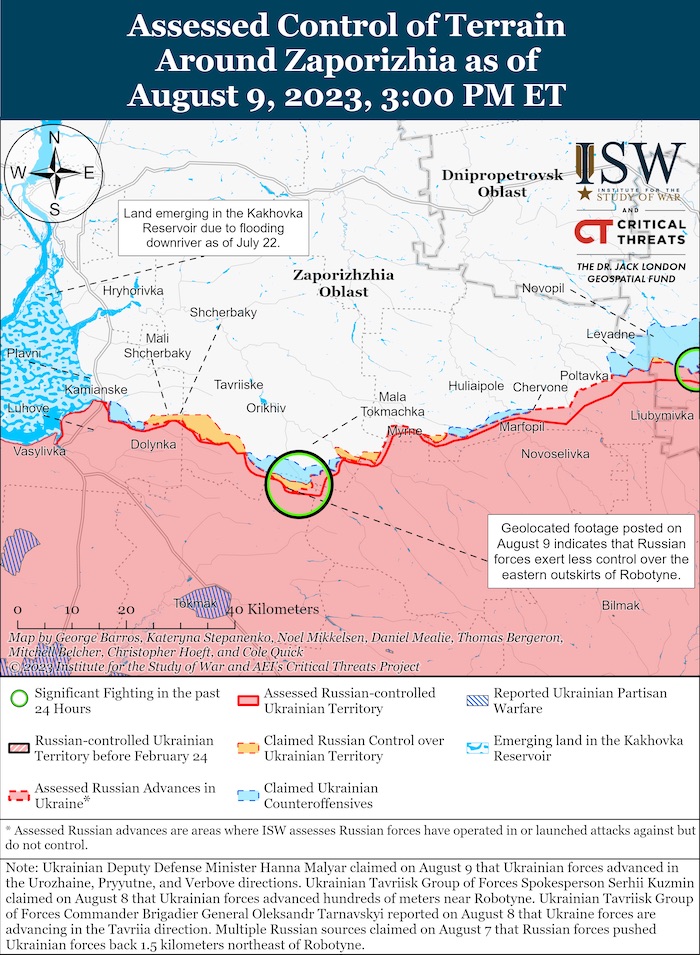
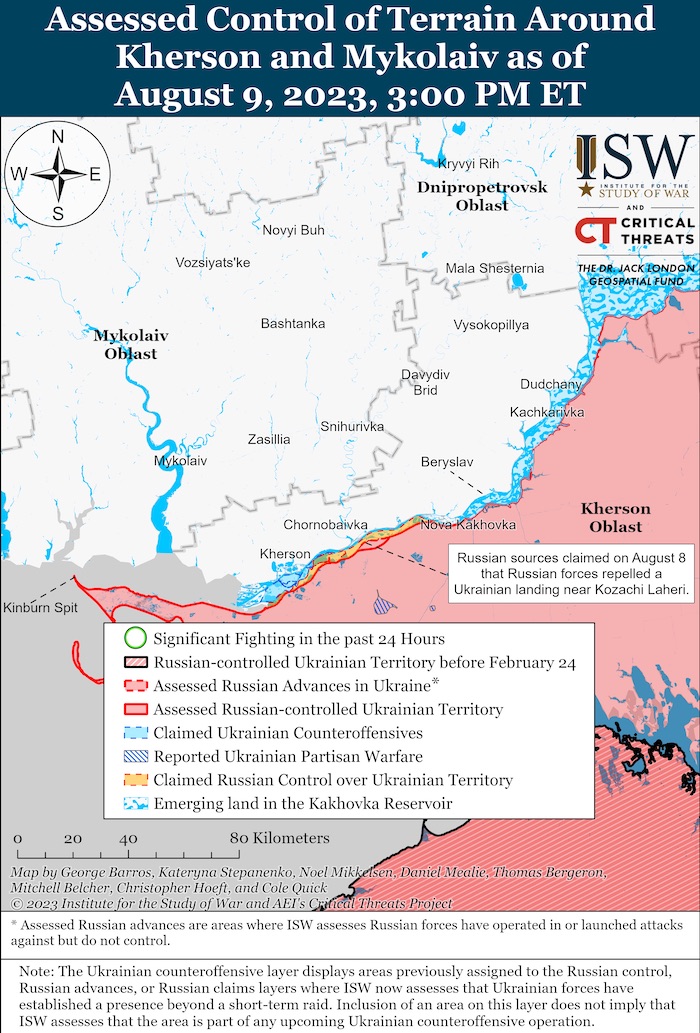
Military Updates
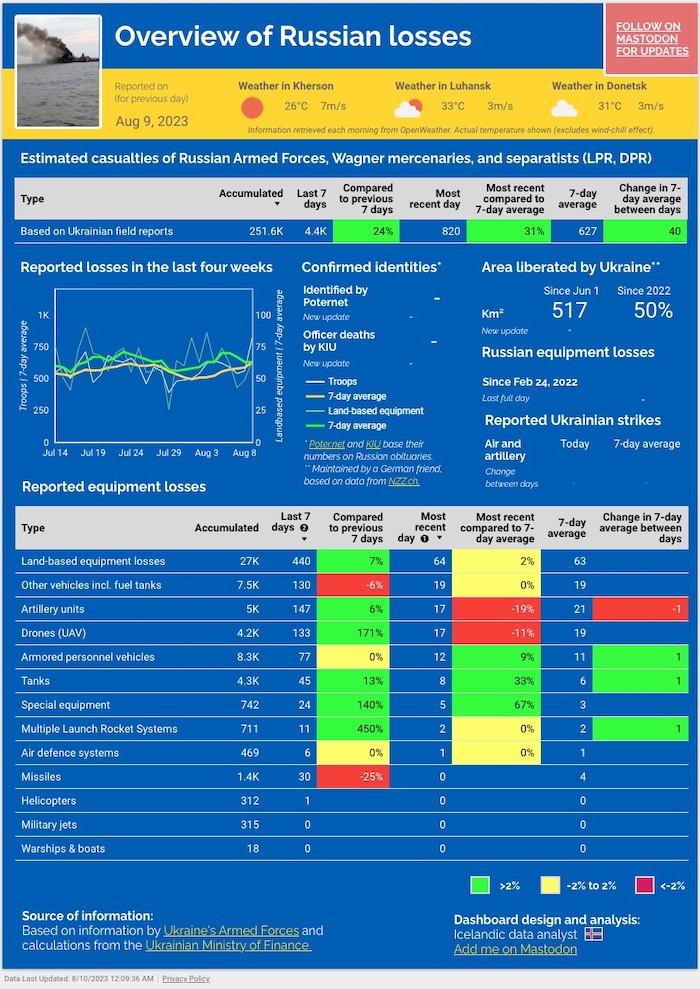
Old weapons, new tricks: Ukraine’s air defense adapts to beat Russia. Ukraine can’t shield its whole territory from Russian missiles, but with layered defenses, 80-90% shoot-down rates, and help from civilians’ apps, Ukrainian air defense blocks Russia’s air superiority even while reanimating WWII techniques.
Poland strengthens border security with Belarus deploying 2,000 more soldiers. Poland is to deploy twice as many as planned troops to the border with Belarus within the next two weeks amidst several attacks on Polish security forces launched from Belarus.
Ukraine advances further in the southern frontline in three directions. The Defense Forces of Ukraine continued an offensive operation in the Bakhmut, Melitopol, and Berdiansk directions and advanced further, Ukrainian General Staff informed. The information was confirmed by DeepState map and various Russian bloggers, who added that intensive fighting continues in the areas for each position, slowing the advance.
Ukraine conducts successful raid across Dnipro river in new direction east of Kherson. Ukrainian special forces likely conducted a successful raid across Dnipro in an unexpected direction east of Kherson. Unlike previous raids on Dnipro islands near Oleshky, this time, Ukrainian troops reached the mainland eastern bank of the river near Kozachi Laheri village. However, whether Ukrainian troops have established an enduring presence on the east bank remains unclear.
From Javelin sims to suicide subs: Five top Ukrainian military technology innovations. In the skies, on the ground, and in the waters of Ukraine, a new era of warfare has emerged. It includes drone combats, psychological warfare, the adoption of advanced Western weapons, and precision strikes with underwater torpedoes.
According to British Defence Intelligence, (last 48 hours):
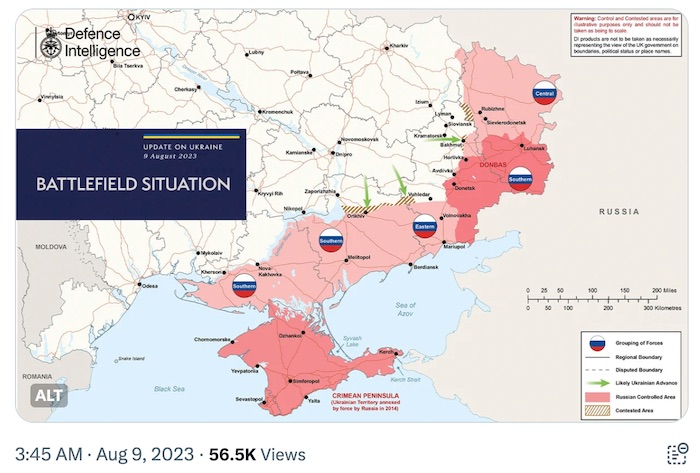
- Over the last week, the Russian authorities have likely increased their ongoing efforts to disrupt Russian citizens’ access to Virtual Private Networks (VPNs). Reports suggest many of the most popular VPNs have become unusable in some regions of Russia.
- VPNs allow users to obfuscate their access to the internet, to maintain privacy and to bypass state-imposed censorship. VPNs are hugely popular in Russia, despite being illegal since 2017. They allow users to access objective international news sources, including about the war in Ukraine.
- VPNs likely represent the greatest single vulnerability within the Russian state’s attempts at pervasive domestic information control. As well as increased technical disruption, the Russian state has also launched a public information campaign, attempting to scare citizens into avoiding VPNs by claiming they put their personal data at risk.
Losses of the Russian army
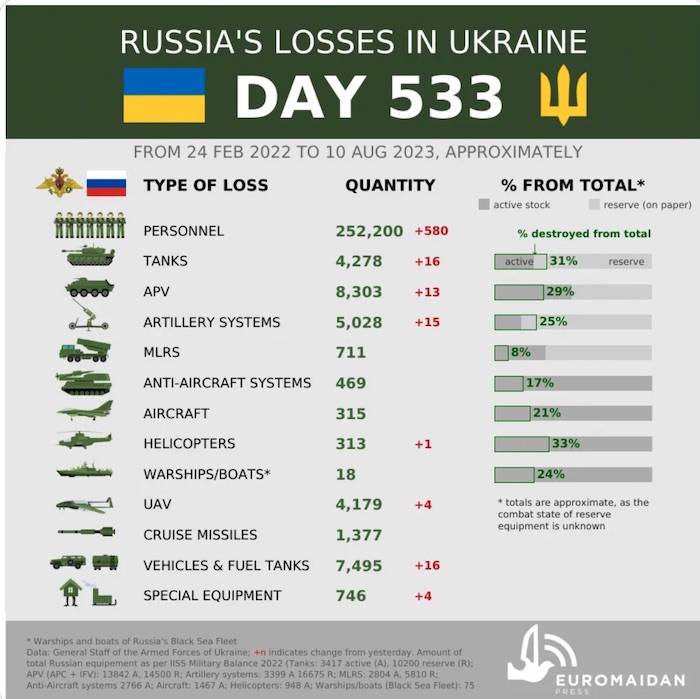
Humanitarian
Amputations in Ukraine may be approaching World War I scale. Since the start of the full-scale war, it is estimated that tens of thousands of Ukrainians have experienced limb loss. Reports suggest that between 20,000 and 50,000 Ukrainians have had one or more limbs amputated due to the ongoing warfare, WSJ found. These estimates originate from prosthetics films, medical practitioners, and charitable organizations.
Russian attack on Zaporizhzhia residential area claims three lives. Russian military forces have launched an attack on a residential district in Zaporizhzhia, resulting in the tragic loss of three lives. From 19:40 to 20:25, air raid alarms were activated in Zaporizhzhia Oblast. Simultaneously, Yuriy Malashko, Head of Zaporizhzhia State Administration, reported instances of “strikes hitting a civilian infrastructure target.”
Environmental
Frontline visible on heat map due to reduced agricultural activity. The massive line of the Russian-Ukrainian front is clearly visible on a heat map, TEXTY revealed. It can be presumed that in areas not occupied by agriculture, the land temperature is slightly lower compared to other cultivated lands. The data from the MODIS satellite, which records land surface temperatures during the summer months starting from 2000, has been analyzed by TEXTY. Scientists use these indicators to assess climate change. The map of 2023 clearly delineates the front line. This is due to the fact that the land in war zone is not cultivated for agriculture. These areas are overgrown with grass and bushes, and consequently, they receive less solar radiation and thus stay cooler.
Legal
Russia prohibits display of Crimean Tatar flag in Crimean schools. The Russian occupying authorities in Crimea have announced a ban on raising the Crimean Tatar flag alongside the flags of Russia and the self-declared “Republic of Crimea” during school events on the peninsula, KrymSos reports citing its own sources. This decision has also extended to prohibiting certain planned activities, including those commemorating the Day of Remembrance for the Victims of the Crimean Tatar Genocide on May 18. Special committees will be convened in Crimean Tatar schools to evaluate event planning, with the administration considering such activities as potential provocations.
Support
Germany provides two more Patriot launchers to Ukraine. Germany has recently provided further military aid to Ukraine. Among the items delivered to Ukraine are two Patriot missile system launchers. Additionally, Germany has supplied 6,525 155mm smoke ammunition rounds, 10 tracked all-terrain vehicles Bandvagn 206 (BV206), 5 border patrol vehicles, and 4 reconnaissance drones VECTOR, among other aid.
Handelsblatt: Rheinmetall will upgrade 30 Danish Leopard tanks for Ukraine. The German Rheinmetall arms manufacturer has acquired 50 Leopard 1 tanks from the Belgian company OIP Land Systems. It will repair and upgrade the tanks and export about 30 to Ukraine, the Handelsblatt outlet wrote, referring to its sources. Previously, Belgian media reported about the purchase of the 50 main battle Leopard 1 tanks. Initially, Rheinmetall wanted to buy Leopard 1 tanks from Sweden to upgrade and deliver them to Ukraine. However, Switzerland did not issue an export license due to its neutrality.
Swedish company Satcube provides satellite internet terminals for Ukraine. Ukraine will receive satellite communications aid from the Swedish company Satcube. It will send around 100 of its portable satellite internet terminals to Ukraine, the company’s CEO, Jakob Kallmer, told Swedish media. Germany will fund the aid. It will bolster Ukraine’s internet connection, including in the military, in addition to already used Starlink terminals.
New Developments
US gave the “green light” to train Ukrainian pilots on F-16. The United States allowed other countries to train Ukrainian pilots to fly American F-16 fighter jets, Deputy Pentagon spokesperson Sabrina Singh said on 8 August. At a briefing, she mentioned that Denmark and the Netherlands were taking the lead on training, but she didn’t have any further updates.
Prince William and Zelenskyy most liked among Americans, Putin least liked. A recent Gallup poll reveals intriguing insights into the favorability ratings of prominent public figures among Americans, shedding light on the figures that enjoy the most and least favorable opinions across the political spectrum. United Kingdom’s Prince William emerges as the frontrunner for this role of unifying public figures. With a favorable rating of 59%, he shares this distinction with Ukrainian President Volodymyr Zelenskyy, who also holds a 57% favorability rating.
Hungarian minority in Ukraine turns away from Orbán’s pro-Russia stance. The ethnic Hungarian community in Ukraine’s Zakarpattia Oblast is distancing itself from Hungarian Prime Minister Viktor Orbán due to his increasingly pro-Russia stance, Financial Times has found. Hungarians constitute the largest among numerous ethnic minorities in the historically diverse Zakarpattia Oblast, nestled in the Carpathian Mountains in Ukraine amid Romania, Hungary, Poland, and Slovakia. From an initial count of about 150,000, the Hungarian community’s current population stands between 70,000 and 80,000.
Former Austrian Foreign Minister who danced with Putin settles in Russian village. Karin Kneissl, the former Austrian foreign minister who infamously danced with Vladimir Putin at her 2018 wedding, has settled in the small Russian village of Petrushovo, Ryazan Oblast. According to Russian outlet Vid Sboku, Kneissl was spotted at a local festival and confirmed she was renting a home in Petrushovo. “I paid for another month, and then we’ll see. I don’t know anything about my future,” Kneissl remarked.
Huge explosion happened on the territory of Zagorsk military factory near Moscow. A huge explosion happened at the Zagorsk Optical-Mechanical Plant plant near Moscow, according to multiple videos on 9 August 2023. The factory had contracts with the Russian Ministry of Defense. It is part of Shvabe Holding, which produces sights, thermal imagers, laser rangefinders, and other similar products. Shvabe Holding, in turn, is part of Russian State Corporation Rostec. Rostec comprises about 800 enterprises, which together form 15 holding companies, mostly in the defense-industry complex.
Moscow allegedly repelled a night drone attack. Moscow Mayor Sergei Sobianin wrote on the night of 9 August 2023 that two combat drones allegedly flew toward the city. He claimed that air defense shot both down—one in the Domodedovo district and the second near the Minsk highway.
Assessment
- On the War
The Institute of Study of War has made the following assessment as of 9 August:
Speculations about the Wagner Group’s withdrawal from Belarus suggest that aspects of the deal between Russian President Vladimir Putin and Wagner Group financier Yevgeny Prigozhin following Wagner’s armed rebellion on June 24 have collapsed. A Russian insider source claimed on August 8 that Wagner forces are conducting their first stage of withdrawal from Belarus by bussing groups of 500 to 600 personnel from Belarus to Krasnodar Krai and Voronezh and Rostov oblasts and that the second stage will begin after August 13.[1] The insider source and a Wagner-affiliated source speculated that Wagner forces may be leaving Belarus because Belarusian President Aliaksandr Lukashenka refused to finance Wagner when he discovered that Russia would not be paying for Wagner as he had evidently expected.[2] Putin and Lukashenka allowed Wagner forces and Prigozhin to continue to operate in Belarus after the armed rebellion.[3] The insider source claimed that a small group of Wagner instructors would remain in Belarus to train Belarusian forces.[4] ISW has not observed visual evidence of Wagner forces moving out of Belarus, however. The insider source claimed on August 6 that Wagner forces that did not deploy to Libya “urgently” went on leave in Russia, and that Wagner's command called on their fighters to keep in touch because new orders could come at any time.[5] Wagner-affiliated sources claimed that the main Wagner forces will “activate” at the end of August but did not elaborate on the statement.[6] Claims that Wagner forces are moving out of Belarus — a relatively safe haven for Wagner and Prigozhin — back to Russia, Wagner command’s mentions of new orders, and claims of the future “activation” of Wagner forces at the end of August likely suggest that aspects of the deal that allowed Wagner to move to Belarus and continue operations there and in Africa have collapsed.
The validity of these claims and the future of the Wagner Group remain unclear at the time of publication. ISW offers the following assessments and hypotheses for the potential implications of these claims, if true, on the Russian power composition, Putin’s regime, and the Russian Ministry of Defense’s (MoD) efforts to integrate Wagner personnel into conventional Russian formations. ISW will continue to monitor and report on indicators and counter-indicators that support, undermine, or inform these hypotheses and assessments.
Putin is likely still concerned about the threat that Prigozhin poses to his long-term goals and continues to focus on definitively separating Prigozhin from Wagner. Putin has previously attempted to present Prigozhin as corrupt and a liar to destroy his reputation among Wagner personnel and within Russian society and to rhetorically separate Prigozhin from Wagner.[7] ISW assessed on June 27 that the Kremlin would likely continue to attack Prigozhin’s character to break Prigozhin’s popular support, discourage Wagner personnel from following him to Belarus, and destroy his financial power.[8] Putin’s June 29 meeting with Prigozhin and 35 Wagner commanders further indicated that Putin intends to maintain the Wagner Group as a cohesive fighting force rather than breaking it up while also seeking to separate Prigozhin from Wagner leadership and forces.[9] Prigozhin’s presence at a Wagner base near Asipovichy, Belarus, on July 18 and on the sidelines of the Russia-Africa Summit in St. Petersburg on July 27 suggests that Prigozhin has maintained his position as the effective leader of the Wagner Group and that Putin has thus far failed to separate Prigozhin from Wagner.[10] A Russian insider source claimed on August 9 that the Kremlin’s rhetorical attacks against Prigozhin decreased dramatically after Putin’s meeting with Wagner leadership on June 29, but began to increase again in early August.[11] An increase in Kremlin attacks on Prigozhin, if true, could indicate that Putin has recommitted to his original goal of destroying Prigozhin and creating a clear separation between Prigozhin and Wagner.
Putin’s prioritization of separating Prigozhin from Wagner and attempting to maintain a reconstituted Wagner fighting element appears to be at odds with Russian Defense Minister Sergei Shoigu’s objectives. A Russian insider source claimed that Shoigu has taken over Russia’s relationships with African countries from Prigozhin, angering the Wagner leadership and personnel and depriving Wagner of opportunities in Africa.[12] If true, Shoigu’s ambitions in Africa are likely to create issues for Putin’s greater goals with Wagner by angering the very people Putin is trying to woo. Putin’s and Shoigu’s priorities have become periodically misaligned throughout the full-scale invasion of Ukraine, often when Putin prioritizes balancing competing groups and interests while Shoigu attempts to establish full control over the Russian military in Ukraine.[13]
Alternatively, Putin may intend for Wagner's forces to return to Russia in order to facilitate the destruction or restructuring of Wagner. Putin appealed to Wagner commanders in a speech on July 26 seeking to persuade them to continue to fight in Ukraine by joining the Russian military.[14] Putin’s appeal may have suggested that the Kremlin intended to organize Wagner forces into the Russian MoD. This appeal appears not to have been successful as many Wagner personnel deployed to Belarus and individual Wagner commanders and personnel continued to express loyalty to Wagner and Prigozhin.[15] The Kremlin has also reportedly attempted to control Wagner’s operations in the Middle East and subordinate Wagner's operations there to the Russian MoD following the rebellion on June 24.[16] Wagner commanders released a statement on August 9 claiming that Wagner fighters have been receiving calls advertising opportunities to work with other private military companies (PMCs) in Africa.[17] The calls may suggest that the Russian government seeks to lure Wagner personnel away from Wagner with new work opportunities. Putin may intend for Wagner's forces to return to Russia so that he can more easily facilitate Wagner’s subordination to the Russian MoD or disband the organization entirely.
There are other possible outcomes that would see Wagner reconstitute as a unitary fighting force reminiscent of its operations in Ukraine, although ISW has observed no indicators for these outcomes, which appear unlikely based on available information. The Kremlin’s likeliest courses of action vis-à-vis Wagner will likely lead to an overall decrease in the combat power that Wagner could offer the Russian military, as either approach will likely dissuade some elements of Wagner from continuing to serve, whether in a Wagner without Prigozhin or in some type of entity completely subordinated to the MoD.
The likely collapse of aspects of the Wagner-Putin-Lukashenka deal indicates that Putin has failed to decisively resolve issues posed by Prigozhin and Wagner following Wagner’s June 24 rebellion. Putin is unlikely to resolve the Wagner problem as long as tensions remain between Putin’s own aim of separating Prigozhin from Wagner and Shoigu’s aims to secure full MoD control over Wagner and the other armed forces fighting for Russia. Speculations about Shoigu taking over Russian military operations in Africa from Wagner, if true, will likely only exacerbate tensions between the MoD and Wagner personnel returning from Belarus or Africa to Russia rather than persuading the Wagner personnel to join conventional Russian military formations in accord with the prior deal.[18] Pro-Wagner sources have historically coalesced around Prigozhin because of anger at the MoD and likely retain the ability to rally the support of Wagner rank-and-file and supporters regardless of Prigozhin‘s actual participation in current rhetoric.[19] Angering Wagner personnel further while bringing them back to Russia poses challenges if Putin seeks to eliminate the Wagner threat. Putin’s decision to allow Shoigu to undermine this aspect of the prior deal, if true, then threatens to undermine the careful façade of internal security that Putin has extensively attempted to project following the June 24 rebellion.[20] This situation is evolving dynamically in an increasingly complicated information environment marked by the absence of direct commentary from Prigozhin or other Wagner leaders. ISW will continue to evaluate these and other hypotheses and assessments as more information becomes available.
Russian Defense Minister Sergei Shoigu attempted to justify the recreation of the Moscow and Leningrad Military Districts by reamplifying boilerplate rhetoric posturing NATO as an existential threat to Russia. Shoigu opened a meeting of the Russian MoD Collegium on August 9, focusing on issues related to the creation of the two military districts but primarily commented on Western support for Ukraine and NATO’s expansion.[21] Shoigu stated that the NATO countries’ attempts to help Ukraine win are creating serious risks for further escalation and that Finland’s accession and Sweden’s planned accession to NATO are “a serious destabilizing factor.”[22] Shoigu stated that it is likely that NATO will deploy military contingents and strike weapons on Finnish territory that can strike critical targets in Russia, and Shoigu accused NATO of intentionally militarizing Poland as part of America’s alleged anti-Russia policy.[23] Shoigu stated that Eastern European militaries have a combined manpower of 360,000 personnel with 8,000 armored vehicles, 6,000 artillery systems, and 650 aviation units deployed to the immediate vicinity of the borders of the Union State.[24] Shoigu suggested that the Russian MoD is strengthening the Russian grouping of forces along Russia’s western borders to respond to these alleged threats.[25] Shoigu announced on January 17, 2023, that the MoD will reestablish the Moscow and Leningrad Military Districts as part of long-term goals to significantly increase the size of the Russian military.[26] Shoigu is likely framing the recreation of these military districts as a necessary response to alleged Western aggression towards Russia in order to justify the cost of resources, time, and institutional capacity required for their recreation.
Ukrainian forces continued counteroffensive operations on at least three sectors of the front and advanced in some areas on August 9. The Ukrainian General Staff reported that Ukrainian forces continued counteroffensive operations in the Bakhmut, Berdiansk (Donetsk-Zaporizhzhia Oblast border area), and Melitopol (western Zaporizhzhia Oblast) directions.[27] Geolocated footage published on August 9 suggests that Ukrainian forces advanced northeast of Robotyne in western Zaporizhzhia Oblast, but the duration and extent of these advances are currently unclear.[28] Ukrainian Tavriisk Operational and Strategic Group of Forces Spokesperson Serhii Kuzmin stated on August 8 that Ukrainian forces reached the Russian first line of defense in an unspecified area in the Melitopol or Berdiansk directions.[29] Ukrainian Deputy Defense Minister Hanna Maliar reported on August 9 that Ukrainian forces were partially successful south of Velyka Novosilka near Urozhaine and Pryyutne and southeast of Orikhiv near Verbove.[30] A prominent Russian milblogger claimed that Ukrainian forces advanced into Urozhaine in the Donetsk-Zaporizhzhia Oblast border area and suggested that Ukrainian forces may have captured some Russian positions south of Bakhmut.[31] Maliar stated that the Ukrainian forces are conducting the counteroffensive as expected and are successfully degrading Russian offensive potential as Ukrainian forces did during the summer-autumn 2022 interdiction campaign in Kherson Oblast.[32]
The Russian veteran community may be attempting to rehabilitate the nominal Russian deputy theater commander in Ukraine, Army General Sergei Surovikin, following scrutiny over his affiliation with the Wagner Group. Surovikin’s former commander, Colonel General Valeriy Marchenkov, told state affiliated URA.ru outlet that Surovikin did not and could not ever renege on his oath and praised Surovikin for pioneering a defensive strategy that is slowing down Ukrainian counteroffensive operations in southern Ukraine.[33] Marchenkov claimed that Surovikin successfully reduced the frontline length and strategically redistributed Russian forces in Zaporizhzhia Oblast. Marchenkov also defended Surovikin’s decision to withdraw Russian troops from the west (right) bank of Kherson Oblast in November 2022, stating that this decision allowed Russian forces to construct the current defensive lines in Kherson Oblast and prevent military and civilian deaths. Marchenkov also attributed the creation of the Russian military police to Surovikin and boasted about Surovikin’s efforts to suppress the August 1991 coup in Moscow. Russian veterans communities were instrumental in rehabilitating and promoting Surovikin’s claimed affiliate, Russian Airborne (VDV) Forces Commander Colonel General Mikhail Teplinsky, in March-April 2023.[34] Russian VDV veterans appealed to Russian President Vladimir Putin on behalf of Teplinsky, after which Teplinsky returned to the frontlines ahead of the Ukrainian counteroffensive.[35] Former Commander of the 58th Combined Arms Army Major General Ivan Popov has also rallied veteran and army groups, sparking a discussion around his removal from command in mid-July.[36]
Marchenkov’s interview may suggest that Surovikin and the anti-Gerasimov faction believe there is a chance for Surovikin to return to the frontlines. Marchenkov’s public defense of Surovikin is in line with previous veteran efforts to secure the reinstatement of commanders who oppose Chief of the Russian General Staff Army General Valery Gerasimov. Marchenkov notably did not publicly disclose Surovikin’s whereabouts. One Russian insider source claimed that the Kremlin’s agreements with Wagner began to “sag,” a claim that accords with ISW’s assessments as noted above, which the source claimed can explain the lack of a new appointment for Surovikin.[37] ISW assessed on April 30 that Putin fails to decisively dismiss commanders and instead demotes them in order to encourage them to seek to regain his favor and to retain options for future appointments.[38] Surovikin’s return to command will likely depend on his ability to convince Putin of his loyalty and usefulness on the battlefield – both narratives presented in Marchenkov’s interview.
Russian sources claimed that poor safety regulations led to an explosion near the Zagorsk Optical Mechanical Plant in Moscow on August 9, and notably, most Russian sources did not suggest that Ukrainian actors may have been responsible for the incident.[39] The explosion caused widespread damage to the plant and surrounding areas, injured at least 60 people, and killed at least one person.[40] The explosion reportedly occurred at a facility at the plant leased by Russian pyrotechnics company PiroRoss, and the Russian authorities have reportedly opened a criminal case against PiroRoss for the violation of industrial safety requirements.[41] Russian sources also claimed that Russian authorities have detained PiroRoss Director Sergei Chanakev in connection with the explosion.[42] Shvabe Holding Company, a subsidiary of Russian state-owned defense conglomerate Rostec, owns the Zagorsk Optical Mechanical Plant, and the plant produces pyrotechnics and precision optical equipment for the military.[43] Russian media outlet Agentstvo reported that the Zagorsk Optical Mechanical Plant has also been participating in the development of a next-generation strategic stealth bomber “Poslannik” since 2019.[44]
Key Takeaways:
- Speculations about the Wagner Group’s withdrawal from Belarus suggest that aspects of the deal between Russian President Vladimir Putin and Wagner Group financier Yevgeny Prigozhin following Wagner’s armed rebellion on June 24 have collapsed.
- Putin is likely still concerned about the threat that Prigozhin poses to his long-term goals and continues to focus on definitively separating Prigozhin from Wagner.
- Alternatively, Putin may intend for Wagner's forces to return to Russia in order to facilitate the destruction or restructuring of Wagner.
- The likely collapse of aspects of the Wagner-Putin-Lukashenka deal indicates that Putin has failed to decisively resolve issues posed by Prigozhin and Wagner following Wagner’s June 24 rebellion.
- Russian Defense Minister Sergei Shoigu attempted to justify the recreation of the Moscow and Leningrad Military Districts by reamplifying boilerplate rhetoric posturing NATO as an existential threat to Russia.
- Ukrainian forces continued counteroffensive operations on at least three sectors of the front and advanced in some areas on August 9.
- The Russian veteran community may be attempting to rehabilitate the nominal Russian deputy theater commander in Ukraine, Army General Sergei Surovikin, following scrutiny over his affiliation with the Wagner Group.
- Marchenkov’s interview may suggest that Surovikin and the anti-Gerasimov faction believe there is a chance for Surovikin to return to the frontlines.
- Russian sources claimed that poor safety regulations led to an explosion near the Zagorsk Optical Mechanical Plant in Moscow on August 9, and notably most Russian sources did not suggest that Ukrainian actors may have been responsible for the incident.
- Russian forces continued offensive operations on the Svatove-Kreminna line, in the Bakhmut area, along the Avdiivka-Donetsk City line, along the Donetsk-Zaporizhzhia Oblast border area, and in western Zaporizhzhia Oblast and advanced on the Svatove-Kreminna line, north of Bakhmut, and in western Zaporizhzhia Oblast.
- Ukrainian forces continued counteroffensive operations on at least three sectors of the front and advanced in some areas on August 9.
- Footage published on August 9 further supports ISW’s assessments that the Ukrainian incursion near Kozachi Laheri in the east (left) bank of Kherson Oblast on August 8 was likely a limited raid.
- Russian forces may be moving military equipment through Kazakhstan to Russia, but ISW has observed no geolocated footage confirming these reports.
- Russian officials appear to be setting conditions to justify the possible need to cancel or postpone regional elections in the occupied territories in case of Ukrainian counteroffensive successes.


